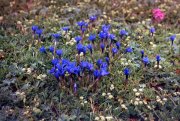 |
QUICK SEARCH
MO PROJECTS:
Africa
Asia/Pacific
Mesoamerica
North America
South America
General Taxonomy
Photo Essays
Training in Latin
America
MO RESEARCH:
Wm. L. Brown Center
Bryology
GIS
Graduate Studies
Research Experiences
for Undergraduates
Imaging Lab
Library
MBG Press
Publications
Climate Change
Catalog Fossil Plants
MO DATABASES:
W³MOST
Image Index
Rare Books
Angiosperm
Phylogeny
Res Botanica
All Databases
INFORMATION:
What's New?
People at MO
Visitor's Guide
Herbarium
Jobs & Fellowships
Symposium
Research Links
Site Map
Search
ORNAMENTAL PLANTS OF HORTICULTURE VALUESelection of perennials
G. dshimilensis C. Koch (sect. Chondrophylla) Caucasus, Anatolia and Balkan Peninsula. In meadows in the alpine zone. Rhizome with numerous stems 3-8 cm. Rosette leaves lanceolate, 7-11 cm long; flowers solitary, bright violet, 2-4 cm long, sessile. V - mid spring to early autumn. Fl - June-August depending on locality and elevation. Fr - in July-October. Pr - by seed. Requires a sunny position, humid air and limestone soil. Suffers from excessive water in winter. Well suited for the rock garden. Z 4. New. A closely related species is G. grandiflora Laxm. from southern Siberia and adjacent Central Asia. A low-growing plant (2-4 cm) with numerous, large (2.0-2.5 cm), dark blue flowers. G. kolakovskyi Doluch. (sect. Pneumonanthe) Caucasus (southwestern regions). In meadows and on rocky slopes in the subalpine zone. Rhizome thick, vertical. Stems numerous, 15-40 cm, erect or ascending, leafy. Leaves sessile, ovate or elongated, 3- veined, 30 (45) mm x 3-4 mm. Flowers solitary, terminal, campanulate, 50 mm long, 10 mm wide, bright blue. V - mid-spring till mid-autumn. Fl - July-August in the wild. Fr - August-September, not every year. P - by seed. Requires a humus-rich soil and a partially shaded site. Z 5 (4). New. G. fischeri P. A. Smirn. (sect. Pneumonanthe) Siberia (southern Altay and Dzungaria). Stems numerous, erect, leafy, 50 cm. Lower leaves scale-like, upper leaves oblong-ovate, 5 cm long. Flowers in dense terminal clusters, campanulate, dark blue, interior green-spotted. V - mid-spring to late autumn. Fl - late summer (August in the wild). Can grow in sunny and partially shaded sites, requires a moist soil. P - by seed. Z 5 (4). New. The following are also of gardening interest:
|
|||
| SELECTION OF PERENNIALS |
© 1995-2025 Missouri Botanical Garden, All Rights Reserved
4344 Shaw Blvd.
St. Louis, MO 63110
(314) 577-5100
Technical Support
